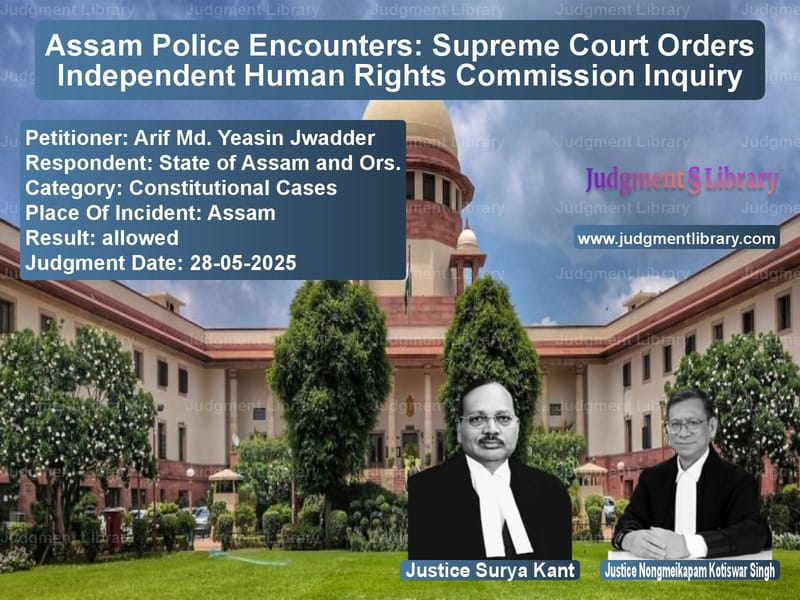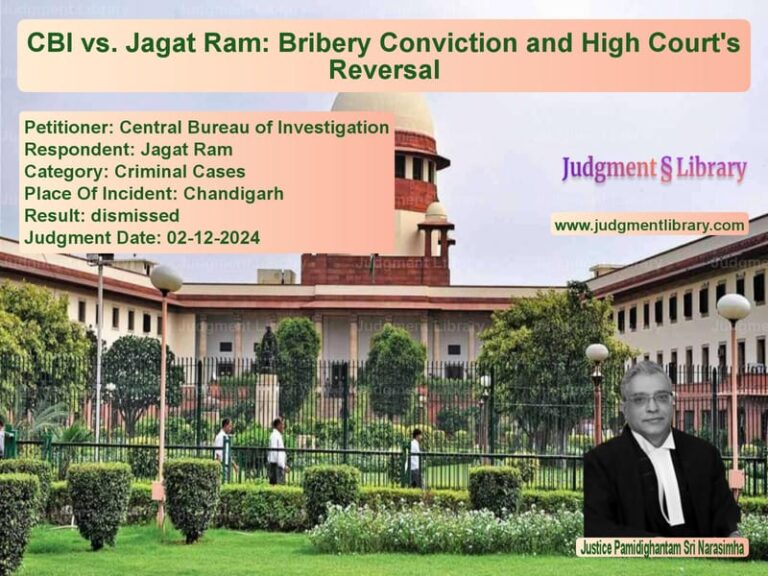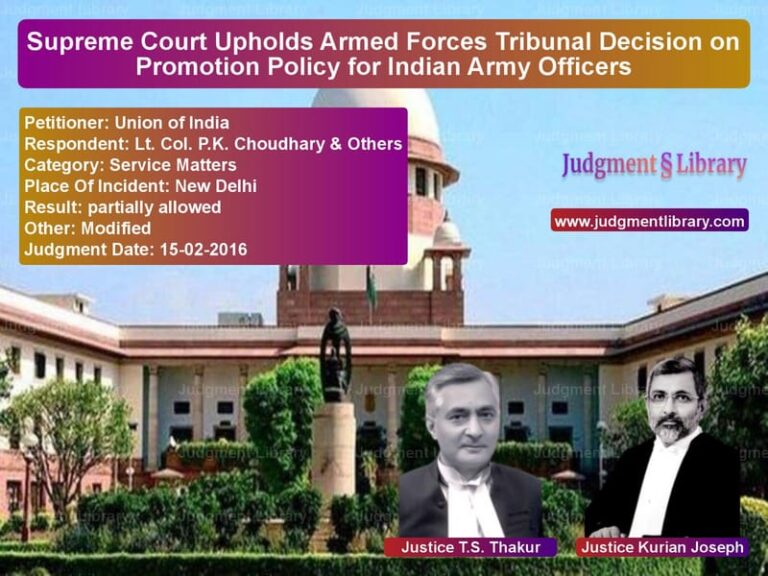Assam Police Encounters: Supreme Court Orders Independent Human Rights Commission Inquiry
The Supreme Court of India recently delivered a landmark judgment addressing grave concerns about police encounters in Assam that resulted in numerous deaths and injuries. The case, Arif Md. Yeasin Jwadder vs. State of Assam and Ors., presented a constitutional dilemma balancing law enforcement imperatives against the fundamental right to life and personal liberty guaranteed by Article 21 of the Constitution.
The matter reached the Supreme Court as an appeal against the Gauhati High Court’s dismissal of a Public Interest Litigation (PIL) that sought records of alleged fake encounters, registration of FIRs against erring police officials, and independent investigations in compliance with established guidelines. The High Court had dismissed the petition as premature and based on vague assertions, though it directed that the appellant be provided all legally permissible documents related to the cases.
The Disturbing Statistics
The appellant alleged that as many as 80 fake encounters took place in Assam between May and December 2021, resulting in 28 deaths and 48 injuries. However, during the proceedings, the State of Assam itself acknowledged in its compliance affidavits that between May 2021 and August 2022, 171 instances of police encounters had occurred, resulting in 56 deaths (including 4 custodial deaths) and 145 injuries. This expanded the scope of the case to scrutinize all 171 alleged police encounters.
The Petitioner’s Arguments
Mr. Prashant Bhushan, learned counsel for the appellant, presented several compelling arguments before the Court. He emphasized that 56 persons have lost their lives and 145 have been grievously injured in police encounters and contended that the guidelines laid down in the landmark PUCL case were not adhered to in any of these incidents.
Among his key submissions was that FIRs pertaining to the incidents of police encounters have been registered against the victims i.e., the persons killed or injured and not against the concerned police officials. This, he argued, directly violated the PUCL guidelines which prescribe that in the event of an encounter leading to death, an FIR shall be registered and forwarded to the jurisdictional court under Section 157 of the CrPC.
Mr. Bhushan also argued that the investigation into these incidents of police encounters has not been conducted in an independent manner. The PUCL judgment mandates that an independent investigation shall be conducted by the CID or police team of another police station under the supervision of a senior officer. However, the investigation into these police encounters was conducted by officers from the same police station.
He described these investigations as merely an eye wash and nothing more than a superficial exercise, intended to create an illusion of accountability. He pointed out that they were riddled with a glaring conflict of interest, compromising the integrity of the process and providing the officers involved with a convenient opportunity to shield themselves from scrutiny.
The appellant also highlighted that a perusal of the 41 FIRs supplied to him indicated a somewhat similar modus operandi adopted by the police officials who have justified the killings and injury caused to people on the pretext that they were trying to flee. This pattern gave rise to the apprehension that the police officials had undertaken these encounters in a premeditated manner rather than in genuine self-defense.
Regarding forensic compliance, Mr. Bhushan pointed out that the Magisterial inquiries in several incidents remain silent on whether any ballistic or forensic examinations were ever conducted, despite the PUCL guidelines mandating that police officers must surrender their weapons for forensic and ballistic analysis.
The State’s Defense
The respondents, represented by Mr. Tushar Mehta, learned Solicitor General of India, along with Mr. Devajit Saikia, Advocate General and Mr. Nalin Kohli, Additional Advocate General for the State of Assam, vehemently defended the state’s actions.
They asserted that the High Court has rightly dismissed the PIL as the Appellant failed to establish or point out any lacunae in the investigation conducted into the instances of police encounters. They characterized the issues raised as vague, baseless and whimsical.
The state representatives claimed that in all instances where police encounters have resulted in death, separate FIRs have been lodged; independent investigations have been conducted; and Magisterial inquiries have also been ordered. In its affidavit, the State of Assam categorically stated that 171 cases had been registered and investigations were currently underway.
Regarding the requirement of independent investigation, they argued that the reliance placed by the Appellant on Para 31.3 of the judgment in PUCL (supra) to suggest that ‘an independent investigation into the incident shall be conducted by the CID or police team of another police station’ in every incident, is completely misplaced and incorrect. They contended that such recourse becomes necessary only when a prima facie case has been made out that investigation is not being carried out in accordance with due procedure.
On the forensic reports issue, the respondents submitted that the Appellant has sought to present unsubstantiated claims without being supported by any cogent facts. They claimed that ballistic examination reports and forensic reports were received and duly considered, albeit at a later stage in some cases.
The state also challenged the applicability of PUCL guidelines to grievous injury cases, arguing that the judgment only provides that the guidelines will also apply to grievous injury cases in police encounters, as far as possible. They emphasized that the phrase ‘as far as possible’ shows that compliance need not be made in a strict sense.
The Court’s Analysis of PUCL Guidelines
The Supreme Court began its analysis by examining the context and framework of the PUCL guidelines, which arose from allegations of fake or staged police encounters in Maharashtra and other parts of the country. The Court noted that fake encounters are extra-judicial killings and must be subject to strict legal scrutiny.
The Court emphasized the critical guidelines from PUCL, including: If pursuant to the tip-off or receipt of any intelligence, as above, encounter takes place and firearm is used by the police party and as a result of that, death occurs, an FIR to that effect shall be registered and the same shall be forwarded to the court under Section 157 of the Code without any delay.
Another crucial guideline states: An independent investigation into the incident/encounter shall be conducted by the CID or police team of another police station under the supervision of a senior officer. Additionally, A Magisterial inquiry under Section 176 of the Code must invariably be held in all cases of death which occur in the course of police firing and The police officer(s) concerned must surrender his/her weapons for forensic and ballistic analysis.
The Court underscored that these guidelines, in a way, reaffirm the primacy of the Rule of Law as the bedrock of our constitutional democracy. It authoritatively held that no individual or institution, including the Police or law enforcement agencies, is above the law. The Court cautioned against the emerging culture of glorifying police encounters as indicators of effective policing or public heroism and observed that such glorification distorts the role of the Police in a constitutional democracy and fosters a climate of impunity, where extra-judicial methods are valorised over legal processes.
The Court made a powerful statement about constitutional principles: It needs no emphasis that, the use of excessive or unlawful force by public authorities, irrespective of the nature of the offence or the antecedents of the victim, cannot be condoned or legitimised on any pretext. Any derogation from the principles of due process, even in the name of expediency or public safety, erodes the foundation of a democratic and civilised society.
Addressing the Appellant’s Locus Standi
The Court dedicated significant attention to the question of whether the appellant, as a third party, had the standing to maintain these proceedings. It acknowledged that since the evolution of the PIL jurisdiction, particularly post the landmark pronouncements beginning in 1984, the doctrine of locus standi has been considerably liberalised.
However, the Court also sounded a note of caution: However, with the widening of the gates to justice, comes an enhanced responsibility upon the court to ensure that this jurisdiction is not invoked in a manner that causes more harm than good. Where the alleged cause espoused by a third party in the form of a PIL relates to a specific individual or a closed set of individuals — particularly where the implications of judicial intervention may directly alter or jeopardize the legal position of the victim or their kin — it becomes imperative for the courts to tread with utmost circumspection.
The Court expressed concern about The danger of an unintended miscarriage of justice or irreversible prejudice being caused to an invisible and voiceless victim or their family, merely because a well-meaning but distanced individual has approached a Writ Court.
Nevertheless, the Court acknowledged the appellant’s role in bringing to the court’s attention a matter that raises grave and disquieting concerns. It recognized that It is not uncommon in situations involving alleged abuse of power by State actors for the affected individuals to remain silent, either out of fear or lack of resources.
The Court struck a delicate balance, noting that The issuance of broad-brush directives without individual scrutiny could result in a miscarriage of justice, either by shielding the guilty or by stigmatizing legitimate action by public servants discharging their duty under challenging circumstances.
The Court’s Factual Findings
After comprehensive examination, the Court found that several instances cited by the Appellant to demonstrate procedural non-compliance of PUCL (supra) guidelines are factually incorrect or incomplete. The appellant had failed to independently place cogent or verifiable material on record to substantiate the allegations, relying mainly on data furnished by the State itself.
The Court observed that prima facie it seems that barring a few cases, it is difficult to infer that there has been a procedural breakdown or the PUCL (supra) guidelines were flagrantly violated. Further, in the absence of independent corroboration or affidavits from affected persons, the assertions remained more or less speculative.
However, the Court also noted concerning gaps: the record remains inconclusive as to whether this procedural safeguard was uniformly followed in all encounter related incidents, as is mandatorily required. While partial compliance was visible, the absence of a clear and consistent procedural trail in some cases called for closer administrative scrutiny.
On forensic analysis, the Court found that while the State had acknowledged that relevant reports were obtained and considered, such consideration occurred belatedly. The Court emphasized that the procedural sanctity envisaged by this Court necessitates that such reports be requisitioned and evaluated at the earliest possible stage to ensure fairness and objectivity.
The Path to Justice: Entrusting the Matter to AHRC
Despite finding that the appellant hadn’t conclusively demonstrated procedural violations, the Court held that this Court cannot remain indifferent where the rights and dignity of individuals, particularly in the context of alleged extra-judicial actions, are at stake.
The Court decided to entrust the inquiry to the Assam Human Rights Commission (AHRC), noting that the AHRC is now headed by an erudite jurist who is a retired Chief Justice of the High Court whose judicial acumen and integrity inspire confidence. The Court set aside the AHRC’s earlier order disposing of the matter and directed reinstatement for necessary inquiry.
In a significant move to ensure genuine participation, the Court directed that the AHRC issue a public notice inviting all individuals who claim to be aggrieved (victims and their family members) by the alleged police encounters to come forward and furnish relevant information or evidence. The notice must be published in national and vernacular newspapers with wide circulation in Assam.
Recognizing the potential risks to witnesses, the Court emphasized that the AHRC may ensure confidentiality with respect to the identity of the victims, their families, or any other individuals who approach it in connection with the inquiry. The Commission was expected to adopt robust measures akin to witness protection protocols to safeguard privacy, safety and security.
The Court also directed that the State of Assam extend full cooperation to the AHRC and ensure that all logistical, financial, and administrative requirements for such an investigation are promptly and adequately met. The Assam State Legal Services Authority was directed to provide legal assistance to victims and their families.
A Landmark for Accountability
This judgment represents a significant reaffirmation of constitutional principles in the face of serious allegations of state excesses. While not making definitive findings about the encounters themselves, the Supreme Court has established a robust framework for their independent examination.
The Court’s approach balanced multiple considerations: the seriousness of the allegations, the rights of victims and their families, the need for proper procedure, and the importance of ensuring that legitimate police actions aren’t unfairly stigmatized. By entrusting the matter to the AHRC with specific safeguards for witness protection and victim participation, the Court has created a model for addressing similar allegations in the future.
This case underscores the enduring relevance of the PUCL guidelines and the judiciary’s role as the guardian of constitutional rights, even when dealing with complex and sensitive matters involving law enforcement agencies. The judgment sends a clear message that in a constitutional democracy, due process and the rule of law must prevail, regardless of the circumstances or the identities of those involved.
Petitioner Name: Arif Md. Yeasin Jwadder.Respondent Name: State of Assam and Ors..Judgment By: Justice Surya Kant, Justice Nongmeikapam Kotiswar Singh.Place Of Incident: Assam.Judgment Date: 28-05-2025.Result: allowed.
Don’t miss out on the full details! Download the complete judgment in PDF format below and gain valuable insights instantly!
Download Judgment: arif-md.-yeasin-jwad-vs-state-of-assam-and-o-supreme-court-of-india-judgment-dated-28-05-2025.pdf
Directly Download Judgment: Directly download this Judgment
See all petitions in Fundamental Rights
See all petitions in Public Interest Litigation
See all petitions in Custodial Deaths and Police Misconduct
See all petitions in Judgment by Surya Kant
See all petitions in Judgment by N. Kotiswar Singh
See all petitions in allowed
See all petitions in supreme court of India judgments May 2025
See all petitions in 2025 judgments
See all posts in Constitutional Cases Category
See all allowed petitions in Constitutional Cases Category
See all Dismissed petitions in Constitutional Cases Category
See all partially allowed petitions in Constitutional Cases Category







